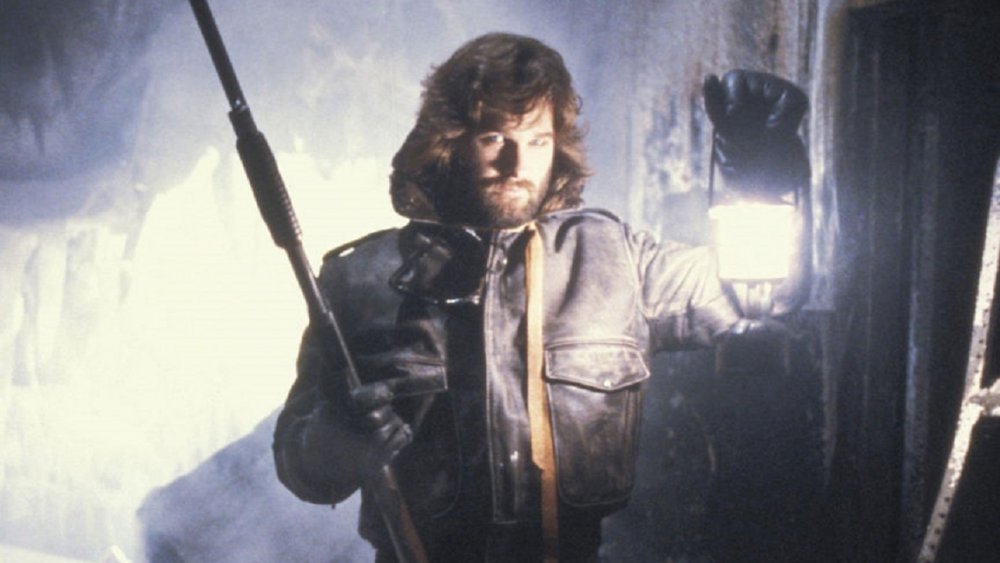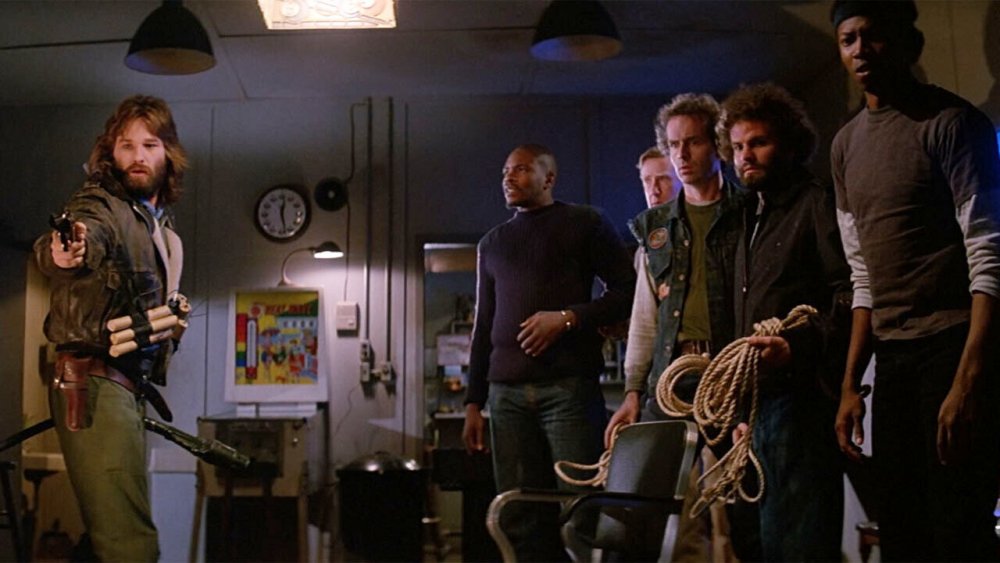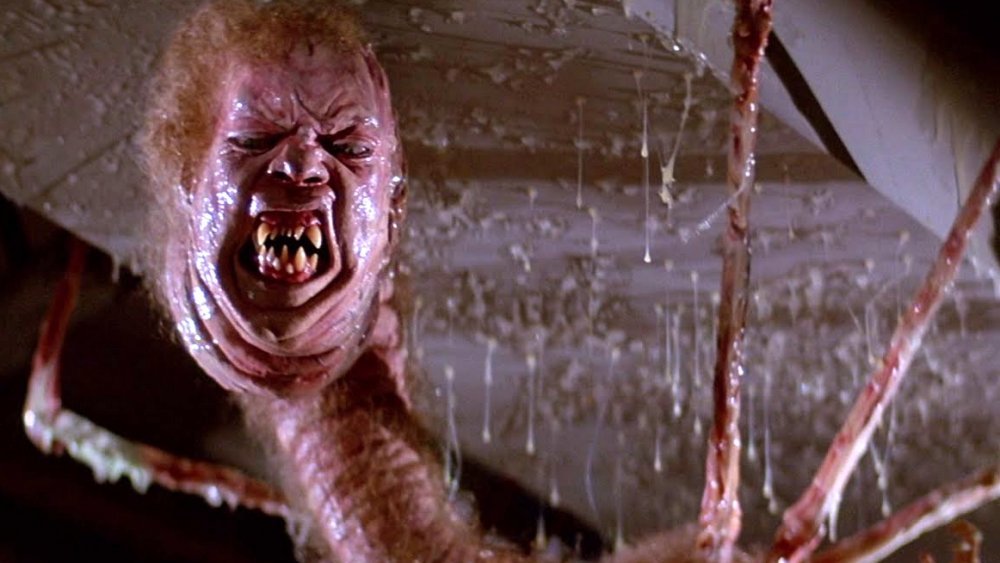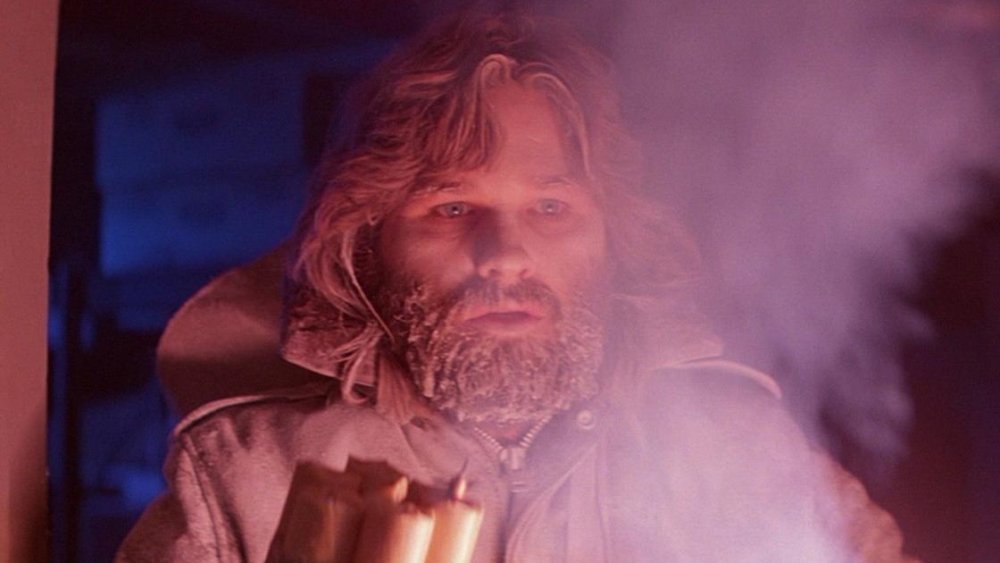The Real Reason John Carpenter's The Thing Flopped At The Box Office
John Carpenter's 1982 film The Thing is widely considered to be among the greatest horror movies of all time. A loose remake of the 1951 creature feature The Thing from Another World — but in actuality, a more faithful adaptation of its source material, the 1938 John W. Campbell Jr. novella Who Goes There? — the film tells the story of a group of researchers at a remote Antarctic outpost who find themselves stalked by an extraterrestrial entity capable of imitating any living being.
Carpenter had already established himself as a maestro of horror and suspense with flicks like 1978's Halloween, 1980's The Fog, and 1981's Escape from New York, and in the summer of '82, anticipation was high for his new fright fest, with its killer ensemble cast featuring the likes of Kurt Russell (a past and future Carpenter collaborator), Keith David, Wilford Brimley, and Charles Hallahan. But when the flick arrived in theaters, a funny thing happened: It wasn't quite received as the classic as which it's recognized today. Rather, audiences stayed away in droves, and critics absolutely savaged the film, pegging it as little more than an egregiously gory freak show with flat characters, a drab visual sense, and a relentlessly bleak tone.
Of course, we now know why Carpenter made some of those choices. The Thing was meant to be bleak, an examination of the frailty of our trust in our fellow human beings set against an impossibly claustrophobic backdrop, with even its macho male archetypes finding that there are some problems that you can't punch, burn, or shoot your way around. Still, how on Earth did a flat-out horror masterpiece strike every wrong chord imaginable with every conceivable audience — even hardcore horror fans — upon it release? Let's take a look at why John Carpenter's The Thing flopped at the box office.
The Thing's tense, paranoid vibe was all wrong for the summer of 1982
In 1982, we were less than a decade into the era of the summer blockbuster, begun in 1975 with Steven Spielberg's Jaws and established in earnest with George Lucas' Star Wars in 1977. In just a few short years, Spielberg in particular had distilled the formula into something resembling an exact science. Following Lucas' The Empire Strikes Back in 1980 and Spielberg's Raiders of the Lost Ark in 1981, moviegoing audiences were ready for another sweeping, transcendent cinematic experience, and Spielberg gave it to them with E.T. the Extra-Terrestrial, released just two weeks before The Thing hit theaters.
The decidedly more family-friendly take on alien visitation wound up becoming the highest-grossing film in history to that point, and The Thing's competition wasn't even limited to that behemoth. Opening a week before Carpenter's grim, icy vision was Star Trek II: The Wrath of Khan, another major hit. Moviegoers who were looking for scares had another option in the relatively gore-free, PG-rated Poltergeist, which also opened a week ahead of The Thing (and which Spielberg produced). All of these films were expertly crafted, slickly commercial genre pictures that took audiences on the kind of thrilling yet safe ride that the previous few summers had conditioned them to expect, and The Thing's shattering of that mold wasn't just met with confusion, but with hostility.
Speaking about that reception in 1999, Carpenter said, "Two weeks before our movie comes out, they release this other movie called E.T. And there's this burst of love all around this movie. I guess the country was going through a recession and there were tough times ... Two weeks later, out comes my movie. And my movie is exactly just the opposite of E.T ... It is a downer. It is the grimmest thing you have ever seen. Here I thought I had made this really great movie, right?" (via This Distracted Globe)
The Thing's special effects were too much for 1982 audiences
The Thing's astonishing visual effects, depicting the monster's assimilation of dogs and humans as well as its tendency to warp into all kinds of bizarre and disturbing forms, were created by then-22 year old Rob Bottin, the protégé of the legendary VFX artist Stan Winston (Winston even pitched in on a few shots, though he declined to be credited). So grueling was the shoot that, after his work was completed, Bottin was admitted to the hospital with exhaustion, double pneumonia, and an ulcer — and for his efforts, he was rewarded with his creations being labeled as borderline obscene by some critics (via WBUR).
Perhaps the two most prominent reviewers of the day excoriated the movie due in large part to Bottin's insanely innovative effects. "The Thing is a great barf-bag movie, all right, but is it any good? I found it disappointing," wrote the great Roger Ebert for the Chicago Sun-Times. "[It's basically] just a geek show, a gross-out movie in which teenagers can dare one another to watch the screen." Ebert's peer and friendly rival, Vincent Canby of the New York Times, was far less kind. "The Thing is a foolish, depressing, overproduced movie that mixes horror with science fiction to make something that is fun as neither one thing or the other," he wrote. "It's entertaining only if one's needs are met by such sights as those of a head walking around on spiderlike legs; autopsies on dogs and humans in which the innards explode to take on other, not easily identifiable forms; hand severings, immolations, wormlike tentacles that emerge from the mouth of a severed head, or two or more burned bodies fused together to look like spareribs covered with barbecue sauce ... It qualifies only as instant junk."
The critical reversal on The Thing might give you whiplash
As a result of The Thing's reception and box office performance — it grossed just under $20 million worldwide — Carpenter was fired from his next gig, the 1984 adaptation of Stephen King's Firestarter, and bought out of his multi-picture deal with Universal. Although he would go on to field more classics throughout the '80s (we're talking Christine, Starman, Big Trouble in Little China, Prince of Darkness, and They Live), the director was devastated by the reaction to The Thing. In 1985, he lamented, "I was called 'a pornographer of violence.' I had no idea it would be received that way ... The Thing was just too strong for that time. I knew it was going to be strong, but I didn't think it would be too strong ... I didn't take the public's taste into consideration" (via Den of Geek).
The thing about the public's taste, though, is that it can shift dramatically in a relatively short time. Contemporary reviews of The Thing near-universally recognize it for what it is: A virtually flawless horror picture, and one of the best in Carpenter's distinguished filmography. It's been called a "perfect movie" lauded for its "groundbreaking visual effects," which "continue to amaze even to this day"; and a "true genre classic" that is "fascinating, horrifying, and utterly engaging from the first frame to the last."
One could make the case that this is par for the course for Carpenter; check that list of his '80s output above one more time, and you'll see that virtually all of those films are much more highly-regarded now than they were upon release. That's the bummer about being a visionary — oftentimes, it takes the rest of the world years just to catch up to you.



